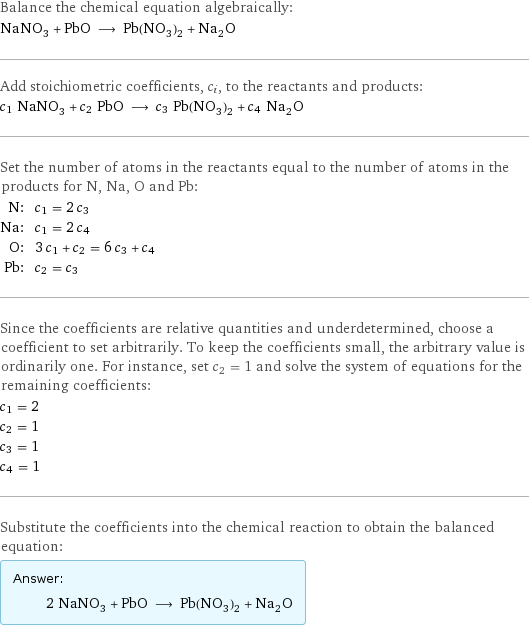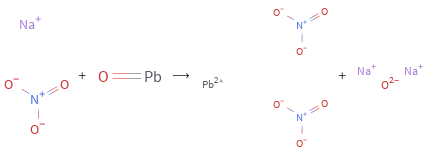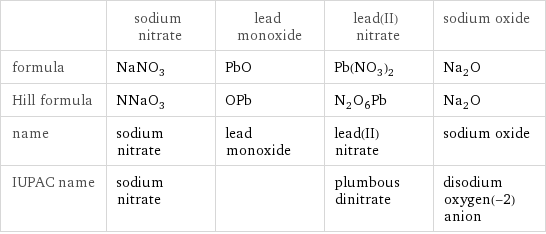Input interpretation

NaNO_3 sodium nitrate + PbO lead monoxide ⟶ Pb(NO_3)_2 lead(II) nitrate + Na_2O sodium oxide
Balanced equation

Balance the chemical equation algebraically: NaNO_3 + PbO ⟶ Pb(NO_3)_2 + Na_2O Add stoichiometric coefficients, c_i, to the reactants and products: c_1 NaNO_3 + c_2 PbO ⟶ c_3 Pb(NO_3)_2 + c_4 Na_2O Set the number of atoms in the reactants equal to the number of atoms in the products for N, Na, O and Pb: N: | c_1 = 2 c_3 Na: | c_1 = 2 c_4 O: | 3 c_1 + c_2 = 6 c_3 + c_4 Pb: | c_2 = c_3 Since the coefficients are relative quantities and underdetermined, choose a coefficient to set arbitrarily. To keep the coefficients small, the arbitrary value is ordinarily one. For instance, set c_2 = 1 and solve the system of equations for the remaining coefficients: c_1 = 2 c_2 = 1 c_3 = 1 c_4 = 1 Substitute the coefficients into the chemical reaction to obtain the balanced equation: Answer: | | 2 NaNO_3 + PbO ⟶ Pb(NO_3)_2 + Na_2O
Structures

+ ⟶ +
Names

sodium nitrate + lead monoxide ⟶ lead(II) nitrate + sodium oxide
Equilibrium constant
![Construct the equilibrium constant, K, expression for: NaNO_3 + PbO ⟶ Pb(NO_3)_2 + Na_2O Plan: • Balance the chemical equation. • Determine the stoichiometric numbers. • Assemble the activity expression for each chemical species. • Use the activity expressions to build the equilibrium constant expression. Write the balanced chemical equation: 2 NaNO_3 + PbO ⟶ Pb(NO_3)_2 + Na_2O Assign stoichiometric numbers, ν_i, using the stoichiometric coefficients, c_i, from the balanced chemical equation in the following manner: ν_i = -c_i for reactants and ν_i = c_i for products: chemical species | c_i | ν_i NaNO_3 | 2 | -2 PbO | 1 | -1 Pb(NO_3)_2 | 1 | 1 Na_2O | 1 | 1 Assemble the activity expressions accounting for the state of matter and ν_i: chemical species | c_i | ν_i | activity expression NaNO_3 | 2 | -2 | ([NaNO3])^(-2) PbO | 1 | -1 | ([PbO])^(-1) Pb(NO_3)_2 | 1 | 1 | [Pb(NO3)2] Na_2O | 1 | 1 | [Na2O] The equilibrium constant symbol in the concentration basis is: K_c Mulitply the activity expressions to arrive at the K_c expression: Answer: | | K_c = ([NaNO3])^(-2) ([PbO])^(-1) [Pb(NO3)2] [Na2O] = ([Pb(NO3)2] [Na2O])/(([NaNO3])^2 [PbO])](../image_source/97c6f0addce625725124fec431718a26.png)
Construct the equilibrium constant, K, expression for: NaNO_3 + PbO ⟶ Pb(NO_3)_2 + Na_2O Plan: • Balance the chemical equation. • Determine the stoichiometric numbers. • Assemble the activity expression for each chemical species. • Use the activity expressions to build the equilibrium constant expression. Write the balanced chemical equation: 2 NaNO_3 + PbO ⟶ Pb(NO_3)_2 + Na_2O Assign stoichiometric numbers, ν_i, using the stoichiometric coefficients, c_i, from the balanced chemical equation in the following manner: ν_i = -c_i for reactants and ν_i = c_i for products: chemical species | c_i | ν_i NaNO_3 | 2 | -2 PbO | 1 | -1 Pb(NO_3)_2 | 1 | 1 Na_2O | 1 | 1 Assemble the activity expressions accounting for the state of matter and ν_i: chemical species | c_i | ν_i | activity expression NaNO_3 | 2 | -2 | ([NaNO3])^(-2) PbO | 1 | -1 | ([PbO])^(-1) Pb(NO_3)_2 | 1 | 1 | [Pb(NO3)2] Na_2O | 1 | 1 | [Na2O] The equilibrium constant symbol in the concentration basis is: K_c Mulitply the activity expressions to arrive at the K_c expression: Answer: | | K_c = ([NaNO3])^(-2) ([PbO])^(-1) [Pb(NO3)2] [Na2O] = ([Pb(NO3)2] [Na2O])/(([NaNO3])^2 [PbO])
Rate of reaction
![Construct the rate of reaction expression for: NaNO_3 + PbO ⟶ Pb(NO_3)_2 + Na_2O Plan: • Balance the chemical equation. • Determine the stoichiometric numbers. • Assemble the rate term for each chemical species. • Write the rate of reaction expression. Write the balanced chemical equation: 2 NaNO_3 + PbO ⟶ Pb(NO_3)_2 + Na_2O Assign stoichiometric numbers, ν_i, using the stoichiometric coefficients, c_i, from the balanced chemical equation in the following manner: ν_i = -c_i for reactants and ν_i = c_i for products: chemical species | c_i | ν_i NaNO_3 | 2 | -2 PbO | 1 | -1 Pb(NO_3)_2 | 1 | 1 Na_2O | 1 | 1 The rate term for each chemical species, B_i, is 1/ν_i(Δ[B_i])/(Δt) where [B_i] is the amount concentration and t is time: chemical species | c_i | ν_i | rate term NaNO_3 | 2 | -2 | -1/2 (Δ[NaNO3])/(Δt) PbO | 1 | -1 | -(Δ[PbO])/(Δt) Pb(NO_3)_2 | 1 | 1 | (Δ[Pb(NO3)2])/(Δt) Na_2O | 1 | 1 | (Δ[Na2O])/(Δt) (for infinitesimal rate of change, replace Δ with d) Set the rate terms equal to each other to arrive at the rate expression: Answer: | | rate = -1/2 (Δ[NaNO3])/(Δt) = -(Δ[PbO])/(Δt) = (Δ[Pb(NO3)2])/(Δt) = (Δ[Na2O])/(Δt) (assuming constant volume and no accumulation of intermediates or side products)](../image_source/28c741d3fad54de87a9ee9dd9dc610dc.png)
Construct the rate of reaction expression for: NaNO_3 + PbO ⟶ Pb(NO_3)_2 + Na_2O Plan: • Balance the chemical equation. • Determine the stoichiometric numbers. • Assemble the rate term for each chemical species. • Write the rate of reaction expression. Write the balanced chemical equation: 2 NaNO_3 + PbO ⟶ Pb(NO_3)_2 + Na_2O Assign stoichiometric numbers, ν_i, using the stoichiometric coefficients, c_i, from the balanced chemical equation in the following manner: ν_i = -c_i for reactants and ν_i = c_i for products: chemical species | c_i | ν_i NaNO_3 | 2 | -2 PbO | 1 | -1 Pb(NO_3)_2 | 1 | 1 Na_2O | 1 | 1 The rate term for each chemical species, B_i, is 1/ν_i(Δ[B_i])/(Δt) where [B_i] is the amount concentration and t is time: chemical species | c_i | ν_i | rate term NaNO_3 | 2 | -2 | -1/2 (Δ[NaNO3])/(Δt) PbO | 1 | -1 | -(Δ[PbO])/(Δt) Pb(NO_3)_2 | 1 | 1 | (Δ[Pb(NO3)2])/(Δt) Na_2O | 1 | 1 | (Δ[Na2O])/(Δt) (for infinitesimal rate of change, replace Δ with d) Set the rate terms equal to each other to arrive at the rate expression: Answer: | | rate = -1/2 (Δ[NaNO3])/(Δt) = -(Δ[PbO])/(Δt) = (Δ[Pb(NO3)2])/(Δt) = (Δ[Na2O])/(Δt) (assuming constant volume and no accumulation of intermediates or side products)
Chemical names and formulas

| sodium nitrate | lead monoxide | lead(II) nitrate | sodium oxide formula | NaNO_3 | PbO | Pb(NO_3)_2 | Na_2O Hill formula | NNaO_3 | OPb | N_2O_6Pb | Na_2O name | sodium nitrate | lead monoxide | lead(II) nitrate | sodium oxide IUPAC name | sodium nitrate | | plumbous dinitrate | disodium oxygen(-2) anion
Substance properties

| sodium nitrate | lead monoxide | lead(II) nitrate | sodium oxide molar mass | 84.994 g/mol | 223.2 g/mol | 331.2 g/mol | 61.979 g/mol phase | solid (at STP) | solid (at STP) | solid (at STP) | melting point | 306 °C | 886 °C | 470 °C | boiling point | | 1470 °C | | density | 2.26 g/cm^3 | 9.5 g/cm^3 | | 2.27 g/cm^3 solubility in water | soluble | insoluble | | dynamic viscosity | 0.003 Pa s (at 250 °C) | 1.45×10^-4 Pa s (at 1000 °C) | | odor | | | odorless |
Units
